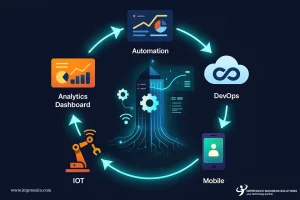How to Future-Proof Your Business – 5 Pillars of a Resilient AI-Driven Enterprise

Disruption today happens faster than ever. Markets flip overnight, customer demand changes, and technology continues to rewrite the rulebook. It is not uncommon for many business leaders to be thinking the same thing: “Is our technology helping us grow, or is it an expensive albatross?”
The reality is, resilience is no longer a choice. Companies that are able to pivot quickly and keep on going, regardless of what they face, are the ones that remain ahead of the pack. Resilience is achieved through the use of intelligent, interconnected technologies that collaborate to make a business more agile and future-ready.
In this article, we’ll walk through the five key pillars of a resilient, AI-powered business—a framework built on real-world experience that helps organizations stay strong and competitive in any situation.
Why Resilience, Not Just Transformation, Matters Most
For years, businesses have been all about “digital transformation.” But one update to your systems isn’t good enough anymore. A really resilient business continues to embrace change. It’s not about transforming once—it’s about being willing to change at all times.
Consider this: a changed business is like a quicker car; a robust business is an all-terrain vehicle with GPS and self-diagnosis functions. One is about speed; the other can drive on anything the road can dish out.
Companies that work with systems in siloes and apply quick fixes tend to scramble when things go wrong. Strong organizations, however, create interdependent systems that learn, adapt, and get better and better over time. That’s the difference between struggling and thriving.
The Five-Pillar Framework for Long-Term Growth
An organization that is future-proofed itself has five interrelated pillars. Imagine them as the foundation of a skyscraper—while each one contributes to strength and stability, combined they form something potent and enduring.
Pillar 1: Intelligent Process Automation — The Central Nervous System
At the core of every successful business lies intelligence—the capability to know, choose, and act rapidly. Intelligent Process Automation (IPA) utilizes AI to automate and make smarter business processes more effective. It’s the command center of your business, orchestrating decisions, actions, and optimizations in the background.
Through the automation of mundane tasks and predictive analytics, businesses are able to save time, minimize errors, and make more informed decisions. It’s not only about speed—it’s about unleashing human potential to do more strategic, creative work.
At Impressico, we apply Generative AI to automate customer support and develop predictive models for inventory and demand planning. Our smart automation transforms routine data into insightful business information, making businesses work smarter, not harder.
Pillar 2: Smooth Human-Technology Interaction — The User Interface
The greatest technology is worthless if it can’t be used by humans. This pillar addresses how humans interact with machines and data using simple, intuitive interfaces.
Mobile apps and IoT solutions allow teams to observe what’s occurring in the moment—from anywhere. When users can easily see and comprehend data, they make quicker, more intelligent decisions.
At Impressico, we build mobile apps that provide leaders and teams with an unobstructed view of their business. Paired with IoT systems monitoring equipment, patient care, or factory output in real time, our apps make it simple for individuals to take action on live data and remain connected to what matters most.
Pillar 3: Unshakeable Operational Core — The Engine Room
Every business requires a trusty engine room—the area where everything hums along. This is known as the Operational Core. It’s established by DevOps methodologies and secure cloud infrastructure that make systems stable and scalable.
Without a solid operational foundation, even the most intelligent technology can collapse. This pillar allows your systems to expand as your business grows, and innovation doesn’t compromise stability or security.
At Impressico, we establish a DevOps culture that enables your teams to move more rapidly and with greater assurance. Our cloud services and automated pipelines ensure smooth deployment of updates, manage increasing workloads, and maintain operations reliably running—no matter how hectic things become.
Pillar 4: Data-Fueled Physical Operations — The Sensory Network
This pillar connects your digital systems with your physical world. Sensors in machines, vehicles, or even food storage areas collect data that helps predict problems before they happen. This real-time feedback allows for smarter planning, less downtime, and better use of resources.
It’s how factories predict equipment issues, how logistics companies track deliveries, and how restaurants ensure food safety—all by listening to what their systems are “feeling.”
Impressico enables companies to create IoT-driven operations that transform their physical assets into intelligent ones. Whether it’s anticipating when a machine will fail, ensuring the best delivery routes, or monitoring temperature for food safety, we utilize real-time data to keep your operations running smoothly and safely.
Pillar 5: Continuous Intelligence & Optimization — The Feedback Loop
The fifth pillar is the one that makes everything get better. It’s the cycle that brings data to learning. Each interaction, order, and service moment creates an opportunity to observe what’s succeeding and what’s failing.
Continuous intelligence tools gather and analyse data from throughout your organization. This creates the ability to make small, consistent changes that produce big outcomes over time.
Impressico serves companies on this complete circle with ongoing intelligence. Our analytics platforms translate customer feedback and service information into actionable insights, allowing companies to adjust performance, enhance experiences, and make informed decisions daily.
Integration is Key: Why These Pillars Need to Function as a Whole
Individual pillars are all valuable in their own right, but true transformation occurs when they all function together. It is the relationship between them that creates a truly resilient business.
Here’s how it all fits together:
An IoT sensor (Pillar 4) picks up on a piece of equipment potentially in trouble. It automatically initiates a workflow (Pillar 1) that generates a maintenance task. That change is rolled out via a DevOps system (Pillar 3) and shows up immediately in a manager’s mobile app (Pillar 2). The outcomes feed back into an analytics platform (Pillar 5), which enables the business to fix the equipment, learn and get better.
That’s what a smart, connected enterprise looks like—everything talking, adjusting, and guiding the next decision.
Ready to Create Your Resilient Business?
Resilience isn’t about not facing challenges—it’s about being prepared to face them. It’s about creating a business that is ready to change, react with confidence, and one that emerges stronger every time.
The five pillars—Intelligent Process Automation, Natural Human-Technology Interaction, Indomitable Operational Center, Data-Driven Physical Operations, and Ever-Smart Intelligence—constitute a tried and tested framework for organizations that wish to remain robust and resilient in the years ahead.
At Impressico Business Solutions we collaborate with organizations to create and implement intelligent, connected systems that render their business future-ready. From automation to analytics, we combine people, technology, and processes to deliver unparalleled resilience.
Partner with Impressico to craft your future-proof business plan.
FAQs – 5 Pillars of a Resilient AI:
-
How long does it typically take to see any ROI after implementing these pillars?
- The timeline for ROI varies based on the specific pillars you implement and your starting point. However, we see results in phased stages:
- Quick Wins (3-6 months): Focusing on a single pillar, like Intelligent Process Automation for a specific department (e.g., automating invoice processing), can deliver measurable cost savings and efficiency gains within a quarter.
- Significant Impact (6-18 months): Implementing a combination of pillars, such as strengthening your Operational Core (Cloud/DevOps) while adding Data-Fueled Physical Operations (IoT), typically yields substantial ROI through reduced downtime, higher productivity, and better resource allocation.
- Transformational Value (18+ months): The full, compounded ROI is realized as all pillars integrate, creating a self-optimizing organization that continuously improves and capitalizes on new opportunities.
- We work with you to prioritize initiatives that deliver tangible value at every stage of the journey.
- The timeline for ROI varies based on the specific pillars you implement and your starting point. However, we see results in phased stages:
-
Is this framework suitable for a mid-sized company, or only for large enterprises?
- This framework is fundamentally about building a resilient and efficient business model, which is crucial for companies of all sizes. In fact, for mid-sized companies, it can be a strategic advantage.
- The key is modular and scalable implementation. A large enterprise might deploy all five pillars simultaneously across the organization. A mid-sized company can start with one or two pillars in a critical area—for example, using Intelligent Process Automation to streamline their sales operations or Seamless Human-Technology Interaction to give their team a better analytics dashboard. The framework is designed to grow with you, ensuring that your technology investments are proportionate to your business needs and to derive maximum value without unnecessary complexity.
-
What’s the first step a company should take if they want to start with just one pillar?
- The most effective first step is always a Resilience Assessment.
- Instead of guessing, we begin by conducting a detailed analysis of your operations to identify the single biggest point of friction, risk, or missed opportunity. We ask: Where are your biggest inefficiencies? What causes the most operational downtime? Where is a lack of data hurting decision-making?
- The pillar we recommend will be the one that addresses your most pressing business pain. For instance, if manual data entry is draining resources, we start with Pillar 1 (Intelligent Process Automation). If system outages are the main concern, we begin with Pillar 3 (Unshakeable Operational Core). This ensures your first step is strategic, focused, and delivers a clear, quick win that builds momentum for future initiatives.
-
How does this approach differ from a standard digital transformation plan?
- A standard digital transformation plan is often a one-time, monolithic project focused on upgrading technology. Our Five-Pillar Framework is about building a state of continuous adaptability.
- A standard digital transformation plan is often a one-time, monolithic project focused on upgrading technology. Our Five-Pillar Framework is about building a state of continuous adaptability.

